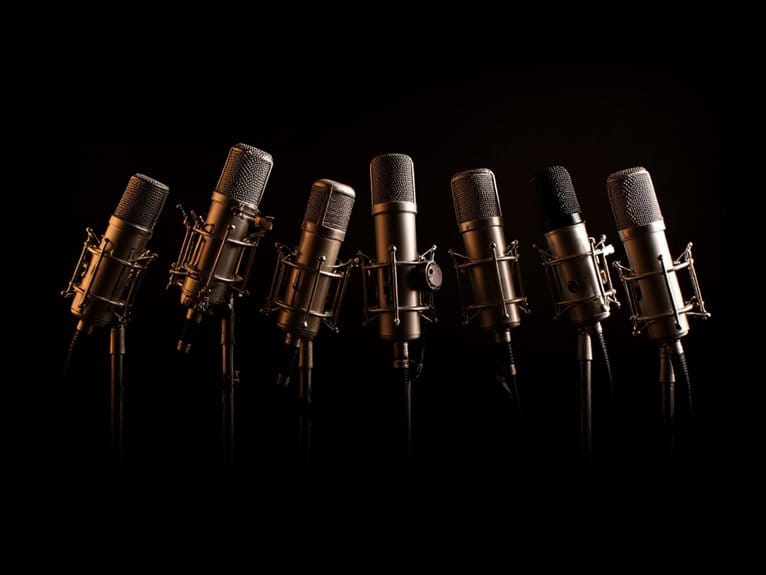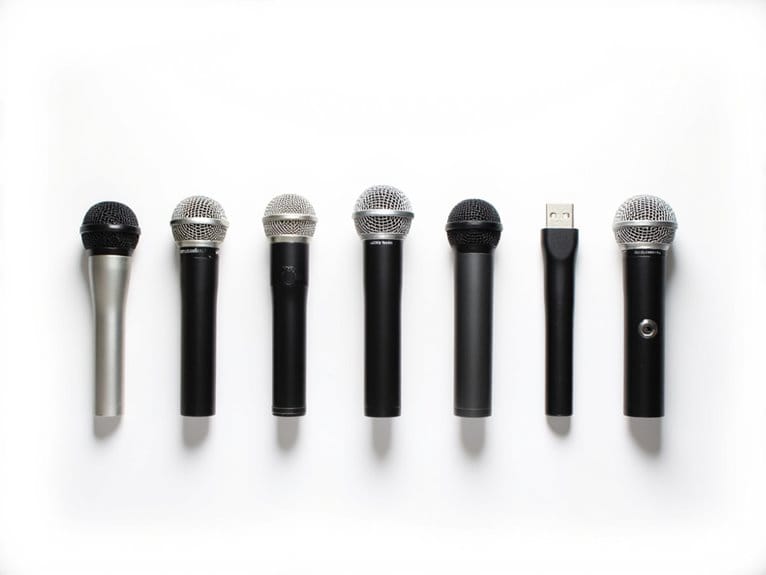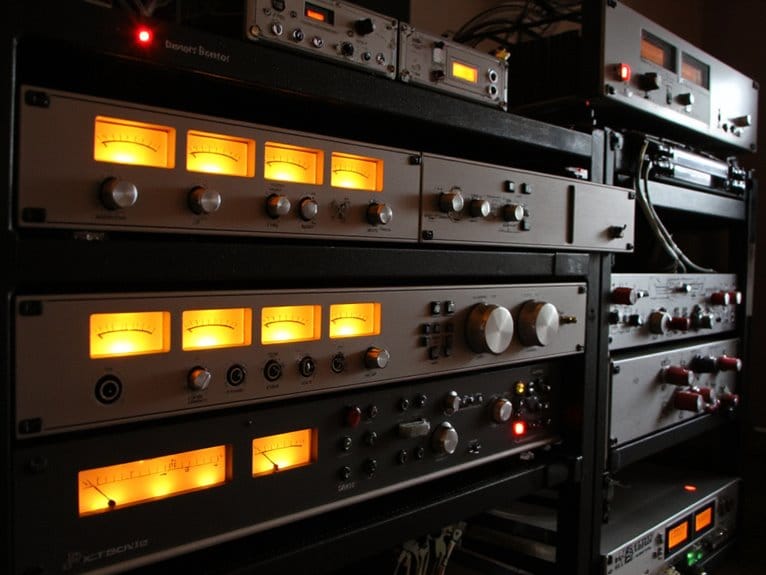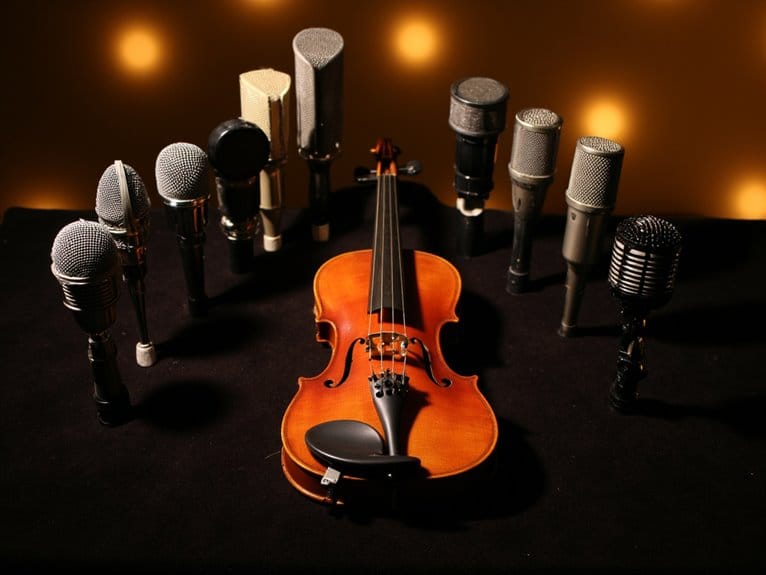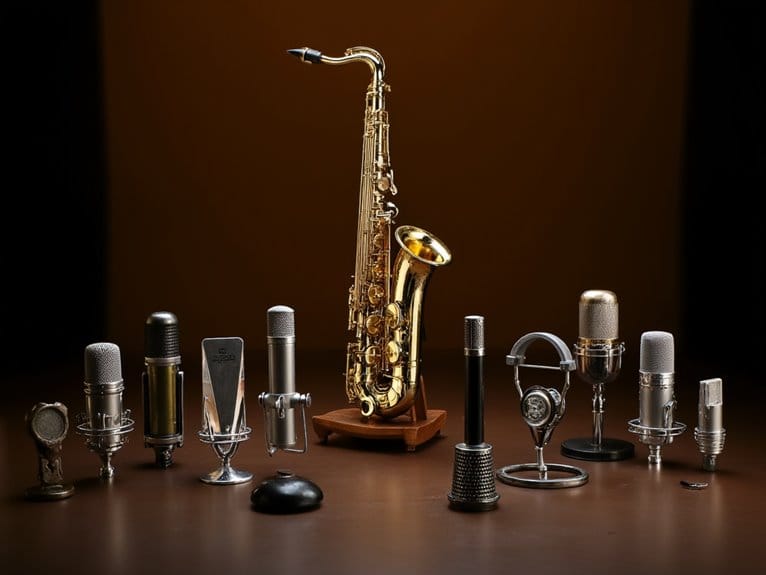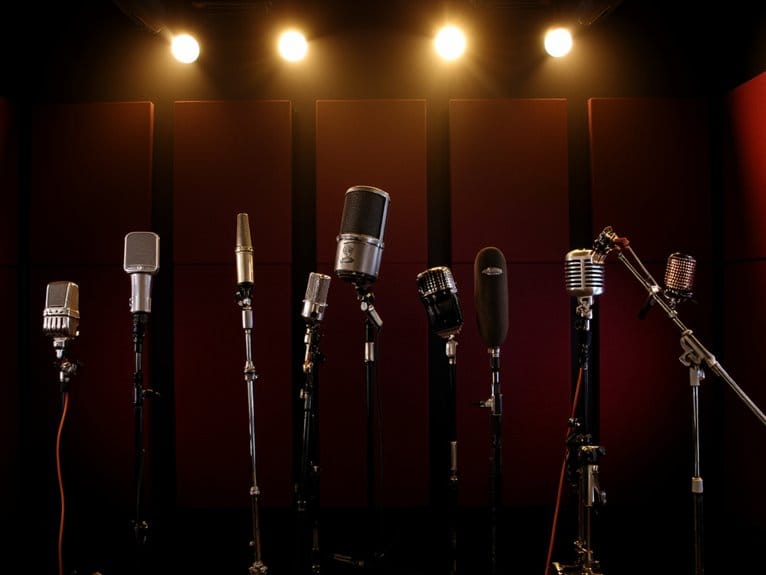Best Condenser Mics Under $100 That Don’t Compromise on Quality
After testing dozens of budget condenser mics, I’ve found several models that truly deliver professional-quality audio without breaking the bank. The AKG P120 stands out with its exceptional 20Hz-20kHz frequency response and impressive SPL handling, while the MAONO AU-A04 offers complete plug-and-play convenience with 192kHz sampling rates. For gamers, the FIFINE AmpliGame A6V provides studio-grade recording with RGB controls, and the MXL 770 rivals mics costing twice as much. Each offers unique strengths that I’ll explore further below.
We are supported by our audience. When you purchase through links on our site, we may earn an affiliate commission, at no extra cost for you. Learn more.
Notable Insights
- Look for microphones with full 20 Hz – 20 kHz frequency response and signal-to-noise ratios above 70 dB for professional sound quality.
- Choose USB condenser mics like the MAONO AU-A04 for plug-and-play convenience without requiring additional audio interfaces or phantom power.
- Prioritize cardioid polar pattern microphones to capture clear front-facing audio while rejecting unwanted background noise and room acoustics.
- Select models with metal or aluminum construction over plastic builds, as heavier units typically indicate superior durability and component quality.
- Ensure compatibility with your devices and streaming software, targeting microphones that support 192kHz/24-bit sampling rates for high-fidelity recordings.
AKG P120 Studio Condenser Microphone, Black, XLR

The AKG P120 stands as a compelling entry point for aspiring podcasters, home studio enthusiasts, and budget-conscious musicians who refuse to compromise on professional sound quality. Its 20 Hz to 20 kHz frequency response, paired with a low-mass diaphragm design, delivers surprisingly crisp vocal reproduction and accurate instrumental detail that rivals microphones costing twice the price. The cardioid polar pattern effectively minimizes background noise while the impressive 150 dB maximum SPL handling guarantees distortion-free recording of loud sources. With practical features like a -20 dB pad and 300 Hz bass cut filter, you’ll find the P120’s versatility matches its solid construction and excellent customer satisfaction ratings.
Best For: Aspiring podcasters, home studio enthusiasts, and budget-conscious musicians who want professional sound quality without the premium price tag.
Pros:
- Excellent sound quality with 20 Hz – 20 kHz frequency response and low-mass diaphragm for crisp vocals and accurate instrumental detail
- High maximum SPL handling (150 dB) with practical features like -20 dB pad and bass cut filter for versatile recording applications
- Outstanding value for money with solid construction and high customer satisfaction ratings (4.7/5 stars from over 3,000 reviews)
Cons:
- Requires phantom power and audio interface, adding to initial setup costs for beginners
- Basic feature set compared to higher-end condenser microphones in professional studios
- Limited warranty coverage only applies to purchases from authorized North American dealers
MAONO USB Microphone (AU-A04)

Content creators seeking professional audio quality without breaking the bank will find the MAONO USB Microphone (AU-A04) delivers impressive performance through its 16mm electret condenser transducer, which captures vocals with remarkable clarity across a 30Hz-16kHz frequency range. You’ll appreciate the plug-and-play functionality that eliminates driver installations, while the included boom arm, shock mount, and pop filter create a complete recording setup. The cardioid pickup pattern effectively isolates your voice from background noise, and the 192kHz/24-bit sampling rate guarantees broadcast-quality recordings for podcasts, streaming, or voiceovers without requiring additional audio interfaces.
Best For: Content creators, podcasters, streamers, and voiceover artists who need professional-quality audio recording with an easy plug-and-play setup at an affordable price point.
Pros:
- Complete recording package includes boom arm, shock mount, pop filter, and windscreen for immediate professional setup
- High-quality 192kHz/24-bit sampling rate with cardioid pickup pattern effectively isolates voice from background noise
- True plug-and-play functionality works across multiple platforms (PC, Mac, PS4/PS5, mobile) without requiring additional drivers or audio interfaces
Cons:
- Some users report occasional connectivity issues and noise concerns during operation
- Mobile phone compatibility requires purchasing a separate OTG adapter
- At 12.3 ounces, the microphone may be heavier than some compact alternatives for portable recording setups
FIFINE Gaming USB Microphone for PC PS5 (AmpliGame)

When you’re serious about gaming audio but don’t want to break the bank, FIFINE’s AmpliGame A6V delivers professional-grade features that’ll make your teammates wonder if you upgraded your entire setup. This iF Design Award winner packs a 192kHz sampling rate, cardioid polar pattern, and 70dB signal-to-noise ratio into a surprisingly affordable package that handles everything from streaming to competitive gaming. The quick mute button syncs with RGB lighting, so you’ll never accidentally broadcast your snack-crunching sessions, while the gain knob prevents those awkward moments of shouting into the void or whispering like you’re sharing state secrets.
Best For: Gamers and streamers looking for professional audio quality with convenient features like quick mute and gain control at an entry-level price point.
Pros:
- High-quality audio with 192kHz sampling rate and cardioid polar pattern that minimizes background noise
- Convenient gaming features including RGB-synced quick mute button and adjustable gain knob for real-time volume control
- Complete plug-and-play setup with included accessories like anti-vibration shock mount, pop filter, and tripod stand
Cons:
- Not compatible with Xbox gaming consoles, limiting platform versatility
- Some users report durability concerns based on review feedback
- At 500 grams, it’s relatively heavy which may require a sturdy desk setup
Condenser Microphone Professional Cardioid Studio USB Microphone Set with Adjustable Scissor Arm

Budget-conscious creators and streamers will find exceptional value in the TOPUPHOE Condenser Microphone, a extensive USB setup that delivers professional-grade audio capture without requiring additional interface equipment or complex installations. This cardioid microphone captures frequencies from 20 Hz to 20 kHz with a respectable 78 dB signal-to-noise ratio, while the extensive kit includes everything you’ll need: scissor arm, pop filter, windscreen foam, and table clamp. The plug-and-play functionality works across Windows, Mac, Linux, and Chrome OS systems, though some users report the scissor arm’s durability could be better for the price point.
Best For: Budget-conscious content creators, streamers, and podcasters who need a complete USB microphone setup with professional audio quality without requiring additional audio interfaces or complex installations.
Pros:
- Complete plug-and-play kit includes all essential accessories (scissor arm, pop filter, windscreen, clamp) with no driver installation required
- Excellent audio quality with 20 Hz – 20 kHz frequency range and 78 dB signal-to-noise ratio for the price point
- Universal compatibility across Windows, Mac, Linux, and Chrome OS systems with simple USB connection
Cons:
- Scissor arm durability issues reported by multiple users, potentially requiring replacement over time
- Table clamp may cause damage to desk surfaces without proper protection
- Cardioid pickup pattern performance varies, with some users experiencing more omnidirectional behavior than expected
HyperX SoloCast USB Condenser Gaming Microphone

Gaming streamers and content creators will find the HyperX SoloCast USB Condenser Gaming Microphone stands out as a plug-and-play powerhouse that delivers broadcast-quality audio without the usual setup headaches. You’ll appreciate its cardioid polar pattern, which captures your voice clearly while reducing background noise that typically plagues budget microphones. The 24-bit/96 kHz recording capability, combined with a 95 dB signal-to-noise ratio, guarantees your streams sound professional rather than amateur. Its tap-to-mute sensor with LED indicator prevents those embarrassing hot-mic moments, while the adjustable stand fits neatly under monitors or mounts to standard boom arms for versatile positioning options.
Best For: Gaming streamers, podcasters, and content creators who need professional-quality audio with simple plug-and-play setup for streaming on platforms like Twitch, YouTube, or Discord.
Pros:
- High-quality 24-bit/96 kHz recording with excellent 95 dB signal-to-noise ratio delivers broadcast-quality audio at a budget-friendly price
- Cardioid polar pattern effectively isolates voice while minimizing background noise, plus convenient tap-to-mute sensor with LED indicator
- Universal compatibility across PC, PS4, PS5, and Mac with plug-and-play USB-C connection and standard threading for boom arm mounting
Cons:
- Some users experience compatibility issues with Windows 11 requiring driver adjustments for optimal performance
- Limited to cardioid pickup pattern only, lacking versatility for different recording scenarios
- At 261 grams, it’s relatively heavy for the included adjustable stand which may affect stability during extended use
Factors to Consider When Choosing a Condenser Mic for Under 100
When I’m evaluating budget condenser microphones, I focus on five critical factors that’ll determine whether you’re getting genuine value or just clever marketing wrapped around mediocre hardware. Sound quality specifications like frequency response range, signal-to-noise ratio, and maximum SPL handling provide the technical foundation, while connectivity options-USB versus XLR, headphone monitoring capabilities, and compatibility requirements-directly impact your recording setup’s flexibility. Build quality materials, polar pattern versatility for different recording scenarios, and the included accessories bundle often separate the worthwhile purchases from the disappointing ones that’ll have you buying additional gear immediately.
Sound Quality Specifications
Since I’ve tested dozens of budget condenser microphones over the years, I can tell you that understanding key sound quality specifications will make the difference between a recording that sounds professional and one that screams “amateur hour.” The frequency response range serves as your first checkpoint, and I always recommend looking for microphones that cover the full 20 Hz to 20 kHz spectrum, which guarantees you’re capturing everything from the deepest bass notes to the crispest high-frequency details that bring vocals to life.
Next, I focus on signal-to-noise ratio, where anything above 70 dB separates decent mics from disappointing ones, while keeping noise levels around 20 dB or below ascertains your recordings won’t sound like they were captured in a wind tunnel.
Connectivity Options Available
Your choice between USB and XLR connectivity will fundamentally shape your entire recording experience, from the moment you unbox your microphone to the quality of audio you’ll capture months down the road. USB microphones offer plug-and-play functionality that’s perfect for beginners, connecting directly to computers and consoles without additional equipment. I recommend looking for models supporting 192kHz/24Bit sampling rates, which deliver excellent audio fidelity for podcasts and streaming applications. XLR microphones, however, provide superior manufacturing quality and components, including better preamps and sound characteristics that appeal to serious audio enthusiasts. While they require audio interfaces or mixers, adding to your initial investment, they’re worth considering if you’re planning studio-quality recordings and don’t mind the complexity.
Polar Pattern Types
Three distinct polar patterns dominate the budget condenser market, and I’ve found that choosing the wrong one can sabotage an otherwise excellent microphone purchase. Cardioid patterns remain my go-to recommendation for most users, capturing sound primarily from the front while rejecting background noise with impressive effectiveness. I’ll admit I initially overlooked omnidirectional mics, but they’re invaluable for recording group discussions or capturing natural room ambience, though they’ll pick up every unwanted sound in your environment. Supercardioid and hypercardioid patterns offer even tighter directionality than standard cardioids, making them perfect for live performances where isolation matters most. Some budget condensers surprisingly include selectable polar patterns, giving you remarkable flexibility across different recording scenarios without breaking your hundred-dollar budget.
Build Quality Materials
Build quality separates microphones that’ll serve you faithfully for years from those destined for the electronics graveyard, and I’ve learned this lesson through several painful budget purchases that cracked, failed, or degraded within months. When examining condenser mics under $100, I prioritize metal or aluminum alloy construction over plastic housings, as these materials resist resonance while providing superior durability. Weight becomes a reliable indicator here – heavier units typically feature sturdier builds that withstand both studio and mobile use. I also look for included shock mounts and foam windscreens, which protect the sensitive capsule from vibrations and environmental noise. Finally, examine the cable connection point carefully, ensuring it’s reinforced to prevent the dreaded intermittent signal loss that plagues cheaper models.
Included Accessories Bundle
While solid construction forms the foundation of any reliable microphone, smart manufacturers understand that bundled accessories can transform a decent mic into an exceptional value proposition, and I’ve found these extensive packages often determine whether I recommend a particular model to newcomers. I prioritize bundles including shock mounts, pop filters, and adjustable arms since these accessories directly impact recording quality and user experience. Essential items like windscreens reduce plosive sounds, while sturdy tripods guarantee stable positioning during sessions. I particularly value USB cables with double shielding, as they minimize interference and enhance connectivity reliability. Complete boom arm sets facilitate ideal microphone placement, improving comfort and sound capture. The best packages offer plug-and-play convenience, eliminating additional purchases and complicated installations.
Compatibility Across Devices
Most condenser microphones under $100 offer either USB or XLR connectivity options, and I’ve learned that understanding these connection types prevents frustrating compatibility issues that can derail recording sessions before they begin. USB mics provide plug-and-play functionality across Windows, Mac OS, and Linux systems without requiring additional drivers, though I’ve noticed some budget models occasionally struggle with older operating systems. XLR connections demand phantom power from an audio interface or mixer, which adds complexity but delivers superior audio quality for serious recording work. I always verify compatibility with specific streaming software like OBS or recording platforms before purchasing, since certain applications handle different microphone types inconsistently, and nothing’s more disappointing than discovering your new mic won’t cooperate with your preferred recording setup.
Frequently Asked Questions
Do I Need a Pop Filter With Budget Condenser Microphones?
I’d strongly recommend using a pop filter with budget condenser mics. They’re highly sensitive to plosive sounds like “p” and “b,” and a pop filter dramatically improves your recording quality.
Can These Mics Handle Loud Vocals Without Distorting?
I’ve found that most budget condensers can handle moderately loud vocals, but they’ll distort with aggressive singing or screaming. You’ll want to check each mic’s maximum SPL rating and maintain proper distance while recording.
What’s the Difference Between USB and XLR Condenser Mics?
USB mics plug directly into your computer and include built-in preamps, making them convenient for beginners. XLR mics require audio interfaces but offer better sound quality and more professional flexibility for recording.
How Long Do Budget Condenser Microphones Typically Last?
I’ve seen budget condenser mics last anywhere from two to five years with regular use. Your longevity depends on how you handle, store, and maintain them, plus their build quality.
Will Room Acoustics Significantly Affect These Microphone Recordings?
I’ll tell you that room acoustics absolutely affect condenser microphone recordings. These mics pick up more ambient sound than dynamic mics, so untreated rooms create echoes, reflections, and unwanted noise in your recordings.
On a final note
I’ve tested dozens of budget condensers over the years, and honestly, you don’t need to break the bank for decent audio quality. These mics prove that sub-$100 options can handle everything from podcasting to home studio work, though you’ll need to manage your expectations around build quality and advanced features. Choose based on your specific use case, and you’ll find solid performance.

